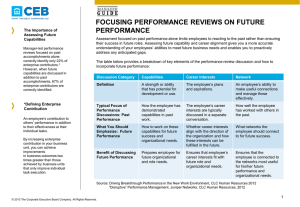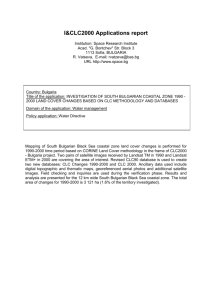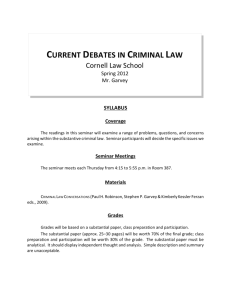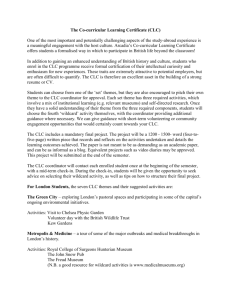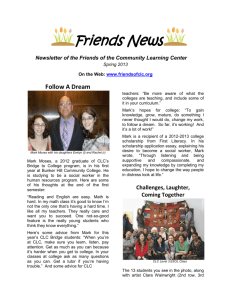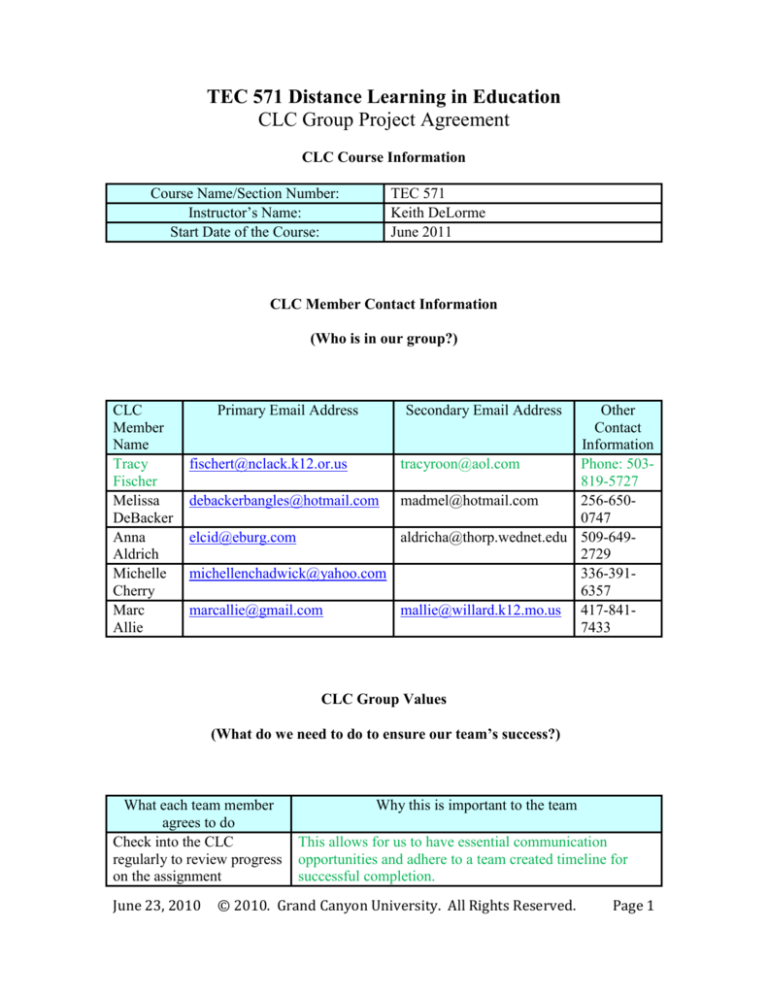
TEC 571 Distance Learning in Education
CLC Group Project Agreement
CLC Course Information
Course Name/Section Number:
Instructor’s Name:
Start Date of the Course:
TEC 571
Keith DeLorme
June 2011
CLC Member Contact Information
(Who is in our group?)
CLC
Member
Name
Tracy
Fischer
Melissa
DeBacker
Anna
Aldrich
Michelle
Cherry
Marc
Allie
Primary Email Address
Secondary Email Address
Other
Contact
Information
fischert@nclack.k12.or.us
tracyroon@aol.com
Phone: 503819-5727
debackerbangles@hotmail.com madmel@hotmail.com
256-6500747
elcid@eburg.com
aldricha@thorp.wednet.edu 509-6492729
michellenchadwick@yahoo.com
336-3916357
marcallie@gmail.com
mallie@willard.k12.mo.us 417-8417433
CLC Group Values
(What do we need to do to ensure our team’s success?)
What each team member
agrees to do
Check into the CLC
regularly to review progress
on the assignment
June 23, 2010
Why this is important to the team
This allows for us to have essential communication
opportunities and adhere to a team created timeline for
successful completion.
© 2010. Grand Canyon University. All Rights Reserved.
Page 1
Contribute ideas and
feedback to the group from
initial discussions
throughout project
completion
Communicate with all CLC
members as soon as a
problem or issue arises
Maintain respectful
communications with all
team members
Complete assigned tasks by
the deadlines set by the
CLC members
Take a leadership role in
CLC assignments
Make sure to cite and
reference all sources of
information used in
completing tasks
Other:
Other:
True collaboration takes into account ideas and thinking of
the whole group. We grow as individuals when we can
expand our thinking due to the whole group.
It is easier to fix problems or issues when they are new
because it is easier to stay focused on the issue. Over time
we may infer things that may not be part of the problem.
Due to the limited time frame for completion
communication on a regular basis is essential to identify
and solve any issues that may come up.
We are more apt to listen to others when the
communication is positive. Everyone’s opinion and ideas
are of value and importance to the CLC project. Disrespect
and negative attitudes have no place in the CLC
environment – these things are counterproductive.
Timely completion of the project is dependent on each of
the component parts. Staying on target also allows peace
of mind to each member of the group.
Leadership roles come in volunteering to do any number
of tasks not just the overseeing of the project. When
members communicate their strengths and their
willingness to do some things out of their comfort zone, it
makes it easier for the group to learn more from the
experience.
This keeps the ethical piece intact for the entire group.
Project Management Specifics
(What needs to be undertaken to complete the CLC project?)
I would like this to be a group effort and am willing to do what needs to be done. I
have indicated the areas that are a strength for me, but am willing to take on any of
these as the group sees necessary.
CLC Group
Member’s Name
All members?
June 23, 2010
Task to be completed by this team member
Due date for
completing the task
for the CLC to
review
Contributing one or more ideas for how the
© 2010. Grand Canyon University. All Rights Reserved.
Page 2
Melissa DeBacker
All members
X
X
Michelle Cherry
project should be completed
Outlining the CLC project
Friday the 29-will
post it to the
discussion as
Outline for CLC.
Assigning tasks to CLC members
Performing research on assigned topics and
writing it up for CLC members to review
Making sure everyone meets their assigned
deadlines for tasks
Proofreading and editing the paper
Submitting the paper via the Assignments
feature by the due date deadline
Other: Backup others in case of
noncompletion?
Other:
CLC Group Interaction Guidelines
(How can we anticipate and deal with group conflict when it arises?)
Communication is key, especially when “life” arises. Establishing how this should
happen is another piece where protocols can be established.
What could happen to
impede our teamwork
A CLC member doesn’t
provide project ideas or
feedback to other team
members
A CLC member doesn’t
complete his or her task at
all
A CLC member completes
his or her task, but turns it
in after the agreed-upon due
date
Other:
Other:
What we will do if this happens
The instructor should be notified and then the other team
members will have to make adjustments and pick up the
slack.
Perhaps a backup person could be assigned
Again the instructor will have to be notified and
unfortunately the team might be cut points. Hopefully this
can be prevented by staying in communication via the
discussion thread, email and phone communication.
CLC Group Review Process
June 23, 2010
© 2010. Grand Canyon University. All Rights Reserved.
Page 3
(What makes a CLC effective?)
What did our CLC do well this time?
What can we do to be a more effective
CLC next time?
Module 6: Assignments
Evaluation Tool
1) Continue working on this assignment according to guidelines presented in Module 5.
2) This assignment uses a grading rubric that can be viewed at the assignment's drop box.
3) Submit the assignment to the instructor by the end of Module 6.
CLC: Peer Evaluation and Reflection
1) Each member of your CLC will post into the CLC forum their individual lesson and
URL at the beginning of Module 6.
2) Individually, using your evaluation tool created during Weeks 5-6 evaluate each
member's lesson and then post your evaluation to their thread. If there are four group
members in the CLC then you will complete four evaluations. Evaluations are required to
be posted during Module 7 as directed by the instructor, however if you complete your
evaluation tool early you may work on it during Week 6. Do not post until Week 7 after
everyone has submitted their evaluation tool for a grade.
a) With the attached evaluation tool, provide a constructive narrative feedback summary
within the post. The narrative will align with the evaluation tool. It should be a minimum
of four sentences.
3) As a group, analyze the commonalities and differences in the evaluation criteria from
the different tools used. Consider what stands out to the group.
4) Reflect on what can be gained from reviewing individual evaluations. How do the
evaluation criteria help in constructing distance learning lessons prior, during and after
implementation? As a group, write a 750-word reflection of this experience addressing
the items mentioned above.
5) Refer to the CLC: Peer Evaluation Grading Criteria located within the Additional
Resources folder in Canyon Connect.
June 23, 2010
© 2010. Grand Canyon University. All Rights Reserved.
Page 4
6) Submit the assignment to the instructor by the end of Module 7.
7) Additionally, submit the assignment in TaskStream. Directions for submitting to
TaskStream can be found on the College of Education page in the Student Success
Center.
Module 7: Assignments
CLC: Case Scenario
1) Each CLC group will be assigned one scenario from the Case Study Resource located
within the Additional Resources folder in Canyon Connect.
2) As a group, examine the issue and describe multiple ways in which it can be resolved.
Within your answers, provide your rationale.
3) There is no word limit on this assignment; however, this is a graduate level course and
answers should be well-developed and supported.
4) APA format is not required, but solid academic writing is expected.
5) Have one CLC member submit the assignment to the instructor by the end of Module
7.
6) Refer to the CLC: Case Scenario Grading Criteria located within the Additional
Resources folder in Canyon Connect.
7) Have one CLC member post the group's response to the Module 8 Discussion Forum
as directed by the instructor.
Module 8: Assignments
1) One CLC member will post the group's response to the CLC: Case Scenario
assignment to the Module 8 Discussion Forum as directed by the instructor.
2) Individually, review each scenario, response, and rationale. Provide feedback,
questions, and add alternative solutions that would be just as effective. This forum is to
provide numerous strategies into which students can receive social support within the
classroom.
3) As a group, your CLC will need to decide on how to respond to all postings made to
your case scenario. This work should be divided equally among the group members.
4) For this discussion forum, refer to the CLC: Case Scenario Grading Criteria located
within the Additional Resources folder in Canyon Connect.
June 23, 2010
© 2010. Grand Canyon University. All Rights Reserved.
Page 5
June 23, 2010
© 2010. Grand Canyon University. All Rights Reserved.
Page 6


